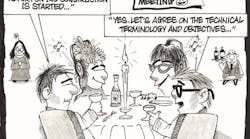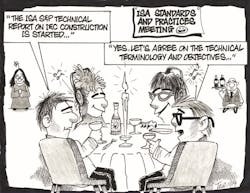This Control Talk column appeared in the December2019 print edition of Control. To read more Control Talk columns click here or read the Control Talk blog here.
Greg: We tend to overlook the expertise needed in instrument and electrical (I&E) construction to make sure automation systems can perform up the limits defined by the design. I have a lot of war stories from when I was in I&E construction. The chemical company I went to work for right out of school had a department in corporate engineering that was I&E Design and Construction with about 200 engineers and technicians. Construction was rarely contracted out back then, and each major plant had at least one I&E construction engineer stationed onsite. Engineers would transfer back and forth between corporate design and plant construction assignments, creating a synergy. Design and construction engineers participated in checkout, water batching and commissioning, finding out firsthand what didn’t work. I spent most the of the 1970s in I&E design and construction, and to this day, the performance of instrumentation is foremost in my mind, as seen in my Control Talk columns, “A meeting of the minds” and “Meeting of minds encore.”
Mike Laspisa offers his insights on the construction scope of work needed based on 37-plus years working in the instrumentation and control (I&C) discipline, including 32 years as a lead I&C engineer or manufacturing plant staff I&C engineer. Mike’s goals are very similar to mine in terms of wanting to share our knowledge, often learned the hard way, to help automation engineers do what’s best.
Mike, what is the purpose of contractor I&C scope of work (SOW)?
Mike: An I&C Contractor SOW must provide an accurate description of all the work needed in the field to have a system ready for commissioning, including all constraints and requirements. I prefer a detailed scope, listing the standard I&C tasks and highlighting any special installation, addition or modification tasks. It also helps to clarify I&C-related work that may be done by other contractors (inline/vessel device installs, control and power wiring) if handled by the electrical contractor; device receipt/storage; plant technician versus contractor device calibration; and specialty work (e.g., fiber or network switch installation and configuration, etc.). Modification/retrofit projects need additional description to convey demo work and staging, or phased installation requirements. A good SOW will result in receiving solid contractor bids, minimizing bidder omissions and/or inflated estimates due to misinterpretations or guesswork, and subsequent construction-phase cost surprises or squabbles over extras.
Greg: Have you seen any deficient contractor scopes in your career?
Mike: Unfortunately, I’ve seen more than a few SOWs with deficiencies. They didn’t provide enough description of the work to clarify or complement the scope attachments (e.g., drawings, specifications, reference documents, etc.). They didn’t highlight any special work requirements, and were very vague in general. Why would anyone think this would be adequate for selecting a contractor or obtaining an accurate cost for the construction phase? I’ve come across a few reasons for engineering firms choosing a bare-bones SOW approach:
- It takes more engineering time to create a detailed SOW. The amount of time estimated for SOW preparation is often criticized during the request-for-quote (RFQ) bid preparation phase by the engineering firm’s project manager.
- A false belief that making a vague SOW will benefit the project by getting the contractor to include work that was not clearly defined for free. In my experience, this has never worked out well. Fighting with the contractor over extras definitely can impact the construction effort, which results in costing more money and/or schedule delays. Time is money during project construction and startup.
- A project management theory that each contractor knows what devices are normally included in their scope.
Greg: What are some good scopes and positive results?
Mike: I have seen very good results (on-schedule and within-budget construction work) on many projects, including multimillion-dollar projects requiring phased installations and a minimum number of production outages. A detailed SOW can also provide a project engineering benefit. If an outline of the SOW is started by mid-project, it can help identify design activities and documents that may have been overlooked or underestimated. It should be written with the contractor focus in mind. A senior engineer who isn’t working on the project, or the department manager, should be able to determine if the contractor can understand the SOW as described and shown on the attached construction documents and installation specifications. The SOW should also be discussed with the other disciplines (mechanical and electrical) to prevent task duplication or omission. Unfortunately, the SOW preparation is sometimes left to the very end of the project and rushed to completion in order to hit a project milestone deadline for Issue for bid or construction releases.
Greg: What can be done to prepare good-quality I&C SOWs?
Mike: The SOW must be written in sufficient detail to clearly identify the required contractor scope of work, including standard tasks (e.g., device/control system receipt/storage/installation; device/panel power, ground, and signal wiring not in electrical contractor scope; instrument air distribution); special tasks (instrument calibration, communication networks, fiber termination, etc.); staged or phased work requirements; demolition/relocation work; hazardous areas and project mitigation approach; and the interaction with the other construction trades. The instrument index should be used to define the various contractor responsibilities for bid purposes and to track changes that occur before/after the I&C package release.
The bare-bones SOW approach must be avoided on projects and discouraged in general. It may come down to I&C lead engineers and/or department managers refusing to give in during project budget preparation. I think it’s pretty clear that the expense of preparing a detailed I&C SOW is far less than the cost to revise/rework a construction effort that was based on a bare-bones SOW.
Greg: One area of particular concern to me that is not emphasized enough is making sure there are I&E construction people who have the technical capability to verify instrumentation installations in terms of meeting requirements per specifications, installation details and wiring diagrams. There also needs to be extensive coordination with project engineers and plant technical support and maintenance people responsible for making sure the automation system meets plant requirements.
As soon as possible upon receipt of instrumentation, I&E construction should verify that the calibration is correct based on nameplate and a spot calibration check. The instrumentation and valves must then be stored in a protective environment. Devices may need to removed or protected during installation of equipment and piping, and sand blasting. Many sensors should not be exposed to the water at the start of water batching due to the presence of nuts, bolts, welding rods, wrenches and debris being flushed out of equipment and piping. Electrodes should not be installed until the line is clean and will remain full of fluid. In my first I&E construction job, on-off valves with spring return piston operators were stored outside. Many did not work during checkout due to severe rusting. In another very large plant, during commissioning I noticed the temperature response seemed very slow. I found out that there was sand in in the bottom of thermowells because connections were open until insertion of the sensor, allowing all kinds of stuff to get into the well, including sand during sandblasting.
During water batching at the same plant, operators complained that control valves were not opening until the controller output was greater than 40%. It turned out the contractor who did the I&E design was adhering to the widely publicized guideline that fast loops should not have positioners. We had good, properly sized diaphragm actuators, so when we added good positioners, the control valves and control loops worked well, responding to small signal changes. For more on when this guideline is wrong, check out item 4 in my Control Talk blog, “Missed Opportunities in Process Control - Part 6.”
For more guidance on I&E installations, read the Control Talk columns, “How to avoid problems in electrical and instrument installations,” “Prevent pressure transmitter problems” and “Your DP problems could be a result of improper use of purges, fills, capillaries and seals.”
10. Mental absence makes the heart grow fonder.
9. Headphones were in use.
8. There was a fair amount of alcohol involved.
7. Spouses have learned to put up with all the jibber-jabber.
6. The picture was taken before the conversation started and they walked off.
5. The food was that good (and nothing else mattered).
4. The picture was photoshopped.
3. The spouses thought it was a comedy routine.
2. The servers took a break to pose in the pic.
1. The spouses are also automation professionals.







